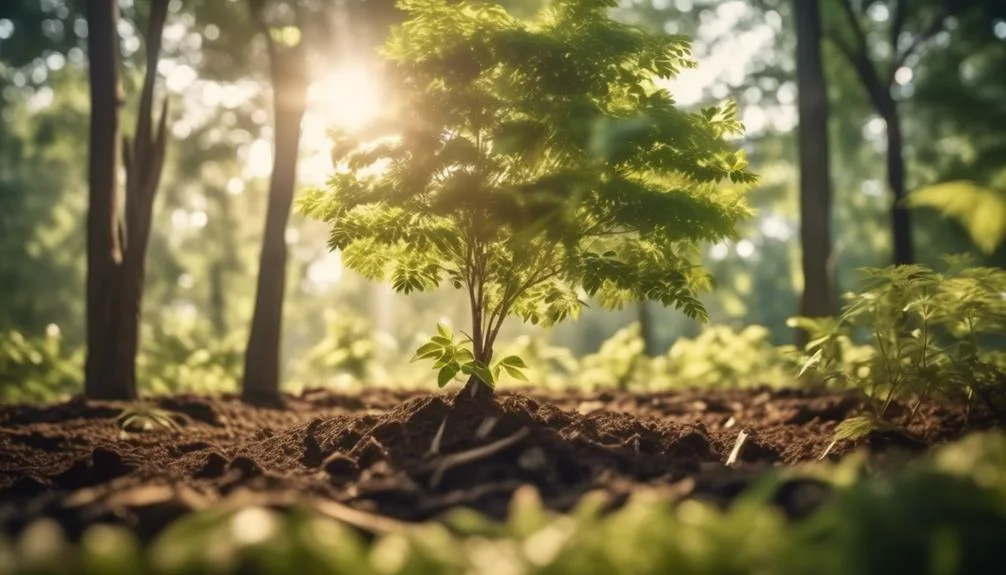Reforestation can be challenging, but have you thought about using hickory trees?
These trees could be a game-changer in reforestation efforts, offering a range of benefits worth exploring.
From their resilience to their impact on the environment, hickory trees have the potential to make a significant difference.
Consider the possibilities of using hickory trees in reforestation and the positive impact they could have on this crucial endeavor.
Suitability of Hickory Trees for Reforestation
Hickory trees are exceptionally suitable for reforestation due to their strong root systems, rapid growth, and ability to thrive in a variety of soil conditions. Their diverse species, such as shagbark, pignut, and bitternut hickory, offer options for different environments and purposes.
These trees not only contribute to the restoration of forests but also provide valuable resources. Hickory trees are known for their nut production, which supports wildlife and offers economic potential. The nuts are a significant food source for various animals, including squirrels, deer, and turkeys.
Moreover, the nuts are edible for humans and have a rich, buttery flavor, making them desirable for culinary use. By utilizing hickory trees in reforestation efforts, you can promote biodiversity, provide habitat and food for wildlife, and potentially even enjoy the harvest yourself.
Benefits of Using Hickory Trees in Reforestation
After recognizing the suitability of hickory trees for reforestation, it becomes imperative to understand the numerous benefits that hickory trees offer to the environment and the community. When used in reforestation efforts, hickory trees contribute significantly to improved soil quality and biodiversity enhancement. Take a look at the table below to see the specific benefits:
| Benefits of Using Hickory Trees in Reforestation |
|---|
| Improved Soil Quality |
| Biodiversity Enhancement |
| Carbon Sequestration |
Hickory trees have deep roots that help prevent soil erosion and improve its structure, leading to enhanced soil quality. Additionally, these trees provide a diverse habitat for various wildlife, thereby promoting biodiversity. By choosing hickory trees for reforestation, you can actively contribute to the restoration and preservation of the environment while creating a thriving ecosystem for future generations.
Considerations for Planting Hickory Trees in Reforestation
When planning the reforestation of an area, it's crucial to carefully consider the optimal conditions for planting hickory trees to ensure their successful growth and contribution to the ecosystem.
Soil conditions play a significant role in the successful establishment of hickory trees. Hickory trees thrive in well-drained, deep soils with a pH range of 5.5 to 6.5. These trees prefer soils that are rich in organic matter and have good aeration. Prior to planting, it's essential to conduct soil tests to ensure that the chosen site meets these requirements.
Additionally, considering the growth rate of hickory trees is important. Hickory trees typically have a slow to moderate growth rate, so it's important to plan for the long-term when integrating them into reforestation efforts.
Role of Hickory Trees in Ecological Restoration
With their deep root systems and ability to provide food and habitat, hickory trees play a crucial role in ecological restoration efforts, contributing to the health and diversity of the ecosystem.
Hickory tree species, such as shagbark and shellbark hickory, are instrumental in restoring degraded landscapes. Their strong root systems help prevent soil erosion, stabilize slopes, and improve water retention, crucial for supporting other plant species and wildlife.
Additionally, hickory trees provide essential food and shelter for numerous animal species, further enhancing biodiversity. By reintroducing hickory trees to ecosystems, it's possible to restore balance and resilience to natural habitats.
The ecological impact of hickory trees in restoration projects is significant, making them valuable assets in efforts to rehabilitate and preserve diverse and thriving ecosystems.
Best Practices for Incorporating Hickory Trees in Reforestation
To ensure the successful incorporation of hickory trees in reforestation efforts, it is essential to consider the specific environmental conditions and the proper planting techniques required for each hickory species. Hickory trees offer numerous benefits, including their strong, durable wood, wildlife habitat provision, and erosion control. When incorporating hickory trees in reforestation projects, careful tree species selection is crucial. Each hickory species has unique growth requirements, such as soil type, moisture levels, and sunlight exposure. Here's a helpful table outlining the key considerations for planting different hickory species:
| Hickory Species | Environmental Conditions | Planting Techniques |
|---|---|---|
| Shagbark Hickory | Well-drained soil, Full sun to partial shade | Deep planting, Mulching |
| Pignut Hickory | Moist, well-drained soil, Full sun | Wide hole, Watering schedule |
Conclusion
Considering the numerous benefits hickory trees offer, they're an excellent choice for reforestation projects. Their ecological significance and potential to restore natural habitats make them a valuable addition.
Planting and nurturing hickory trees can play a pivotal role in environmental restoration.
Why not incorporate hickory trees into your next reforestation endeavor and contribute to a sustainable future?
Mark Hoffman is a dedicated arborist and tree care specialist with over a decade of experience. His love for trees began when he visited Yosemite National Park as a teenager and was awestruck by the giant sequoias. Mark pursued his passion by studying forestry at Michigan Technological University, where he earned a Bachelor of Science degree.
Since then, he has worked tirelessly in the field of arboriculture, helping to preserve and protect trees in his community. His expertise and dedication have made him a respected leader in the industry and a valuable resource for anyone seeking advice on tree care.
